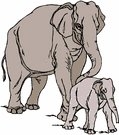
Worksheets and No Prep Teaching Resources
Reading Comprehension Worksheets
Animal Themes
Endangered Animals Theme Unit
Mammals

Animal Themes
 Worksheets and No Prep Teaching Resources Reading Comprehension Worksheets Animal Themes Endangered Animals Theme Unit Mammals |
 Animal Themes |
| edHelper's suggested reading level: | grades 5 to 6 | |
| Flesch-Kincaid grade level: | 5.7 |
| Giant Pandas |

|
 1 An endangered species, the giant panda can only be found in the mountain bamboo forests of western China. There are only about 1,600 wild giant pandas left in the world. Giant pandas are members of the bear family. They are mammals. They have a creamy white fur coat with black bands across their shoulders and black patches over their legs, ears, and eyes. Even though giant pandas look like bears, they do not behave like bears. Unlike their meat-eating relatives, giant pandas are vegetarians for the most part. Their favorite food is bamboo. However, if they are extremely hungry and bamboo is nowhere to be found, giant pandas may eat grass, fruits, or sometimes, small animals like birds and fish.
1 An endangered species, the giant panda can only be found in the mountain bamboo forests of western China. There are only about 1,600 wild giant pandas left in the world. Giant pandas are members of the bear family. They are mammals. They have a creamy white fur coat with black bands across their shoulders and black patches over their legs, ears, and eyes. Even though giant pandas look like bears, they do not behave like bears. Unlike their meat-eating relatives, giant pandas are vegetarians for the most part. Their favorite food is bamboo. However, if they are extremely hungry and bamboo is nowhere to be found, giant pandas may eat grass, fruits, or sometimes, small animals like birds and fish. |
Create Weekly Reading Books
Prepare for an entire week at once! |
| Leave your feedback on Giant Pandas (use this link if you found an error in the story) |
 |
Animal Themes
|
 |
Endangered Animals Theme Unit
|
 |
Mammals
|
|
|